Kiteboarding in Michigan: An In-Depth Exploration
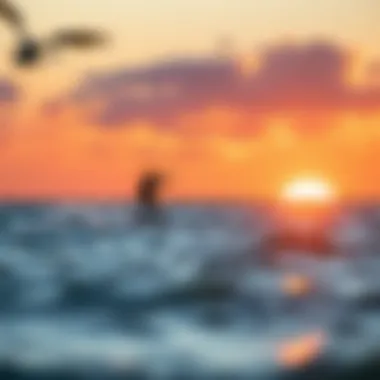
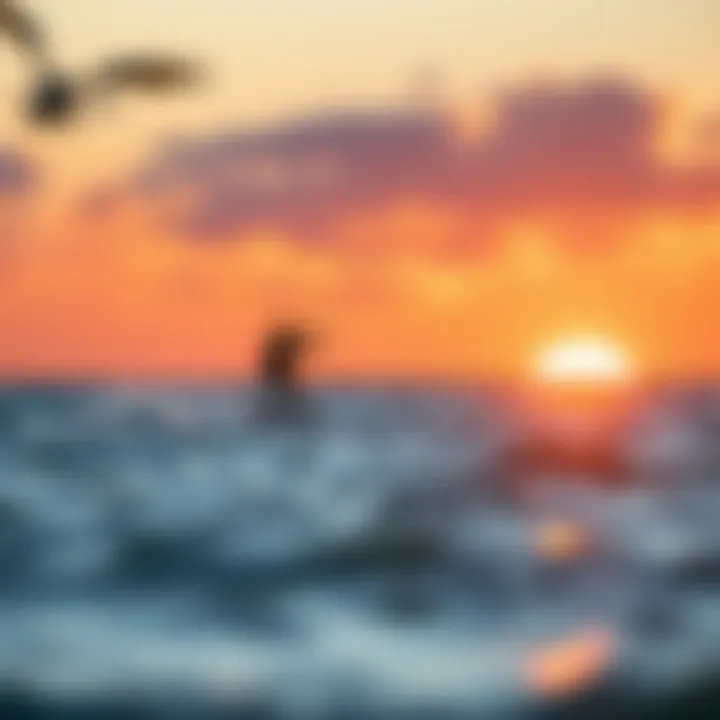
Intro
Kiteboarding in Michigan is more than just a sport; it's an exhilarating experience that intertwines the beauty of nature with the thrill of water and wind. As you stand on the shores of Lake Michigan, with the sun glistening off the water, kiteboarding beckons with a promise of adventure. Over recent years, the sport has gained momentum, attracting both seasoned riders and curious newcomers eager to catch their first gusts of wind.
This guide takes you through the essential elements of kiteboarding in Michigan. From identifying the best sites for launching your kite to unpacking the gear you'll need, each section is designed to enrich your understanding and skills. Whether you are a beginner looking to dip your toes into this adrenaline-pumping activity or an experienced kiteboarder seeking new challenges, this comprehensive guide serves as your trusty companion.
Throughout this exploration, we'll dive into crucial topics like suitable locations, the nuances of equipment, techniques for various skill levels, and safety precautions to keep you riding safely. The local community, with its enthusiastic vibe and camaraderie, adds a unique flavor to the kiteboarding scene.
As we swoop into the gear and equipment necessary for an exhilarating kiteboarding experience, get ready to discover what helps riders soar high and glide smoothly across Michigan's waters.
Prelude to Kiteboarding in Michigan
Kiteboarding is not just a sport; it’s so much more. In Michigan, this exhilarating activity has found a special place, thriving amid the beauty of the Great Lakes. The rising interest in kiteboarding here sparks curiosity and excitement for both seasoned enthusiasts and newcomers. This comprehensive guide serves to illuminate Michigan’s vibrant kiteboarding scene, highlighting the key locations, vital gear, skill development, and safety measures. By diving deeper into what makes kiteboarding in Michigan unique, one can appreciate the sheer joy and thrill it brings.
Understanding the Sport
Kiteboarding combines elements of surfing and paragliding. A kite catches the wind, allowing riders to glide across water while performing stunts and tricks. The basics might appear straightforward, but mastering the sport requires practice, dedication, and an understanding of weather dynamics. Whether you are zipping across waves or drifting gracefully on flat waters, kiteboarding offers a fantastic way to connect with nature. As participants harness the power of the wind, they not only enjoy the thrill of the ride but also embrace deeper aspects of resilience and focus.
The Rise of Kiteboarding in Michigan
Kiteboarding in Michigan has seen a remarkable surge over recent years. Initially, the sport found a home among a small community of adventure seekers, the talk was little more than casual banter. However, as word spread, more individuals began to take notice—spurred by the breathtaking landscapes and vast waterways available for exploration.
With its assortment of kiteboarding locations across the state, from the shores of Lake Michigan to the northern parts around Lake Huron, each spot has its character, attractions, and wind conditions that appeal to various skill levels. Events such as local competitions and community gatherings have fostered a sense of camaraderie among kiteboarders, creating thriving networks of enthusiasts eager to share tips, experience, and fun. This growth signifies not only a shift in recreational pursuits but elevates outdoor lifestyle choices in Michigan, inviting people to appreciate the unmatched beauty of the state’s lakes while engaging in an invigorating sport.
"Kiteboarding in Michigan is more than just a pastime; it's a movement that embraces adventure and community."
Overall, the kiteboarding community here is vibrant, enthusiastic, and welcoming, making it a magnet for those keen to explore the joys of this thrilling sport.
Top Kiteboarding Locations in Michigan
Kiteboarding in Michigan is not just about the thrill of gliding above the water; it's about knowing where to find the best spots to enjoy this exhilarating sport. The state boasts an array of prime kiteboarding locations, each offering its unique blend of factors that cater to both novice and experienced kiteboarders. When exploring these areas, one must consider wind patterns, water conditions, and local communities engaged in the kiteboarding culture. Not only do these locations provide a suitable environment for enjoying the sport, but they also serve as hubs of social interaction for enthusiasts sharing a passion for kiteboarding.
The Great Lakes: An Overview
The Great Lakes are truly a gem for kiteboarders thanks to their expansive waters and varied landscapes. They provide not only ample space for riding but also different conditions that cater to various skill levels.
Lake Michigan
Lake Michigan is often considered the crown jewel of kiteboarding locations in the Great Lakes. With its expansive coastline, it offers a wide range of spots, from tranquil bays to more challenging open waters. The key characteristic of Lake Michigan is its consistent wind patterns, which is a dream for any kiteboarder looking to harness the wind effectively.
- Benefits: The lake's unique feature is its sandy shores and shallow waters, making it a safe playground for beginners who want to practice without fear of drastic falls.
- Disadvantages: However, one should keep in mind that during peak tourist seasons, crowds can be a nuisance, which might affect the overall experience.
Lake Huron
Just east of Lake Michigan lies Lake Huron, less frequented by kiteboarders but boasting its own charms. The waters are crystal clear, and the surrounding scenery is lush and inviting. A notable aspect is the stronger winds that can whip across its surface, providing a delightful challenge for advanced riders.
- Benefits: Lake Huron is known for its stunning sunrises, adding a serene backdrop to those morning sessions.
- Disadvantages: But be aware, the currents can be unpredictable, making it essential for kiteboarders to familiarize themselves with local conditions before hitting the water.
Lake Superior
While Lake Superior might seem intimidating due to its size, it rewards the brave with its majestic beauty. The largest of the Great Lakes, its vast waters and rugged coastline present exciting opportunities for kiteboarders seeking adventure.
- Benefits: Its remote locations allow for less crowded rides, making it ideal for those looking to escape the hustle.
- Disadvantages: That said, the cold waters and the risk of sudden weather changes present a challenge, thus it is more suited for seasoned kiteboarders.
Popular Kiteboarding Spots
Michigan isn't lacking when it comes to specific kiteboarding spots that highlight the state’s diverse environments.
Sandy Hook
Sandy Hook stands out for its stunning natural beauty and perfect wind conditions for kiteboarding. Located in the heart of Michigan, it offers a welcoming environment where kiteboarders can set up and launch.
- Benefits: The shallow waters and expansive sandy beaches make it a preferred spot for beginners as well as a cherished location by experienced kitesurfers.
- Disadvantages: However, due to its popularity, weekends can see an influx of visitors, making it sometimes too crowded on sunny weekends.
North Beach Park
For those looking for more structured facilities, North Beach Park is a great choice. With picnic areas, restrooms, and lifeguards on duty, it provides a safe environment for families who want to enjoy the sport.
- Benefits: It is especially beneficial for kiteboarding events given the ample space and supportive services.
- Disadvantages: The park does require an entry fee, which might not sit well with every budget-conscious kiteboarder.
Empire Beach
Lastly, Empire Beach offers a picturesque setting and is well-known in the kiteboarding community for favorable winds. The calm waters are ideal for beginners, while the more advanced kiteboarders can venture further out into the lake for those adrenaline-pumping rides.
- Benefits: Empire Beach’s scenic sunsets offer a fantastic way to end the day, making it a popular spot for extended sessions into the evening.
- Disadvantages: Local regulations could impose restrictions during peak usage times, so it is wise to check any rules before planning a visit.
Seasonal Considerations for Michigan Kiteboarding
When it comes to kiteboarding in Michigan, the seasons play a pivotal role in shaping the experience, influencing not just the conditions but also the overall enjoyment of the sport. Understanding seasonal variations is essential for selecting the best times and locations for kiteboarding. Each season brings unique characteristics that cater to different skill levels, preferences, and kiteboarding styles. Therefore, considering the seasons will not only enhance safety but also enrich the kiteboarding adventure.
Best Times to Kiteboard
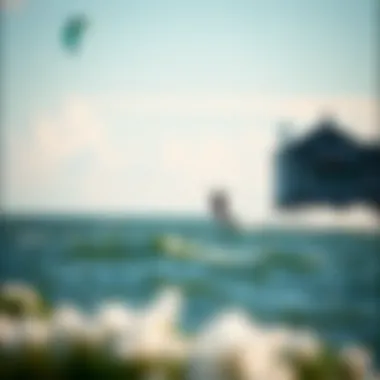
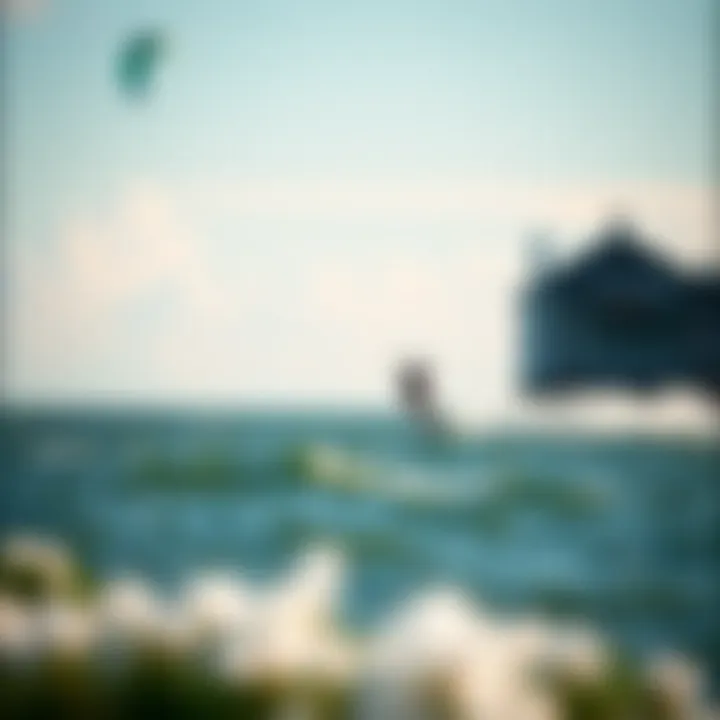
Spring
Spring in Michigan marks the awakening of nature after a long winter, but it also presents a gradual buildup of wind conditions ideal for kiteboarding. Typically, March through May is when the winds start to pick up, offering the much-needed lift to beginners and seasoned riders alike. One key characteristic of spring is the stability of the winds, which leans towards moderate and consistent. The waters might be chilly, but that breeds a bit of adrenaline for those more experienced.
A unique feature of spring is the gradual warming of temperatures. While early spring can be cold with water temperatures still crisp, by late April, you can expect milder conditions. However, those new to the sport may want to keep a wet suit handy, as colder water can be a stark reminder of winter.
Summer
Summer in Michigan offers the quintessential kiteboarding experience with warm weather and vibrant beach culture. During June, July, and August, kiteboarders flock to the lakes to take full advantage of the more reliable winds and pleasant temperatures. The beaches are lined with fellow enthusiasts, creating a lively atmosphere that can enhance the joy of the sport.
The notable characteristic of summer is the strong thermal winds that can pick up, especially in the afternoons. These conditions mean you can enjoy long sessions on the water, allowing you to experiment with more advanced techniques. However, a downside is the potential for overcrowding at popular spots, making it crucial to be mindful of others on the water. The warmth of the summer sun does come with the uncertainty of thunderstorms, so keeping an eye on the weather forecast is wise.
Fall
Fall, often underrated, is a hidden gem for kiteboarders. Between September and November, the winds start to shift into a more dynamic state. The persistent, robust winds make for excellent kiteboarding conditions. While the temperatures begin to drop, the beauty of the autumn leaves creates a spectacular backdrop on the water.
One key aspect of fall is its less crowded beaches compared to summer, as many tourists have packed up for the year. This allows for a more tranquil, personal kiteboarding experience. A unique feature of fall is the unpredictability of weather, with winds potentially shifting more dramatically than any other season. It requires vigilance and flexibility in planning kiteboarding sessions, thus honing your adaptability as a rider.
Weather Patterns to Watch
Wind Conditions
When kiteboarding, Wind Conditions are arguably the most critical variable to monitor. Michigan's geography around the Great Lakes means that wind patterns can be both predictable and varied. Often, late afternoons offer the most reliable winds, thanks to the thermal activity generated by the warming of land masses. This is where knowledge of local spots comes in handy; knowing which areas tend to receive stronger gusts is invaluable for maximizing your time on the water.
A key characteristic is that winds tend to be more consistent during summer months, which makes it a favorite for many kiteboarders. However, transitioning into spring and fall, you might find days with sporadic gusts that can be both exhilarating and tricky. These fluctuations can test both novice and experienced riders, making clear communication about conditions critical among the kiting community.
Temperature Fluctuations
Temperature Fluctuations in Michigan can be quite drastic, particularly when moving from one season to another. In spring, chilly winds can often bite through a wetsuit, while summer brings comfortable warmth and later night chills. These fluctuations influence the type of gear you may need to bring for a kiteboarding session.
During autumn, temperatures begin to drop rapidly, presenting a challenge for those wishing to extend their kiteboarding season. Riders often have to adjust their gear in tandem with the cooling air temperatures, ensuring they stay warm enough to enjoy their time on the water. Additionally, being aware of local temperature impacts—such as how they affect water temperature—can be essential for safety.
Storm Precautions
Storm Precautions is an essential consideration for anyone planning to kiteboard in Michigan. The state is prone to sudden weather changes, particularly in the spring and summer months. Being caught off-guard by a storm can have dire consequences, hence riders need to have a solid understanding of the signs of approaching storms and the precautions that should be taken.
An important characteristic of storm activity in Michigan is its predictability. Meteorological resources, including local weather apps and weather stations, can provide detailed forecasts. Familiarizing yourself with storm shelters and understanding evacuation routes around popular kiteboarding spots is advisable to ensure safety amidst sudden weather changes.
Recognizing the patterns of storms and the necessary precautions will maximize both safety and enjoyment on the water. Kiteboarding should remain a thrilling experience, yet understanding these dynamics can keep it enjoyable long term.
Essential Gear for Kiteboarding
When diving into the exhilarating world of kiteboarding, understanding the essential gear is of utmost importance. The right equipment not only enhances performance but also ensures safety. Kiteboarding gear typically includes kites, boards, and safety equipment, each playing a unique role in the overall kiteboarding experience.
For instance, choosing the right kite affects how you navigate the water and respond to different wind conditions. Similarly, picking a suitable board can significantly impact your riding style and comfort.
Kites: Types and Specifications
Foil Kites
Foil kites are designed uniquely with an internal structure that allows them to inflate with wind. This offers a significant advantage; they create lift and respond quickly to changes in wind. One key characteristic of foil kites is their ability to perform well in light wind conditions. This makes them a popular choice among kiteboarders in Michigan, especially during those breezy summer days.
However, they do come with some challenges. A unique feature of foil kites is their lower wind range compared to leading edge inflatable kites, which can make them less versatile in shifting conditions. Still, for those who master them, the rewards are bountiful.
Leading Edge Inflatable Kites
Leading edge inflatable kites, often seen as the bread and butter of the kiteboarding world, capitalize on their structure primarily developed for stability. A key characteristic of these kites is their ease of setup and ability to withstand stronger winds. This is what draws many kiteboarders to them, including those venturing into the Great Lakes.
Their unique feature is the inflatable leading edge that allows them to maintain shape even in gusty winds. These kites can be inflated quickly, making them a favorable choice for spontaneous adventures. On the downside, they can be less efficient in very light winds when compared to their foil counterparts, putting riders at the mercy of the elements.
Boards: Choosing the Right Fit
Selecting the right board is almost as crucial as the kite itself. Different boards cater to diverse riding styles and conditions, ensuring a tailored experience for each kiteboarder.
Directional Boards
Directional boards are made primarily for downwind riding. They possess a distinctive shape designed to cut through the water with ease. A key characteristic of directional boards is their pointed nose, which assists in maintaining straight lines while gliding.
This makes these boards especially favorable for riders looking to race or enjoy a more surf-like experience on the water. The trade-off is that directional boards can be cumbersome for tricks, making them less appealing for those who lean towards freestyle.
Twin-Tip Boards
Twin-tip boards, on the other hand, provide versatility that many kiteboarders crave. A key characteristic of twin-tips is their symmetrical shape, allowing riders to switch directions effortlessly. This board type is immensely popular among beginners due to its forgiving nature and its capacity to assist in learning various tricks.
The unique feature here is the ability to land both regular and switch, providing flexibility in riding style. Yet, they may not cut through waves as efficiently as directional boards, so it’s essential to weigh options based on individual preferences.
Safety Equipment Essentials
Prioritizing safety gear is crucial for anyone kiteboarding, especially in Michigan, where conditions can change rapidly.
Harness Types
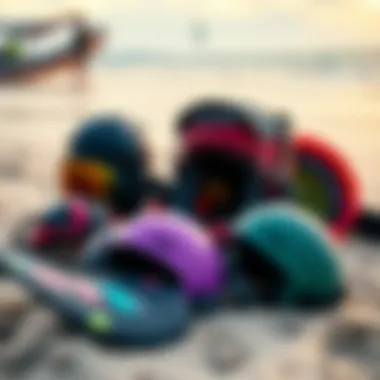
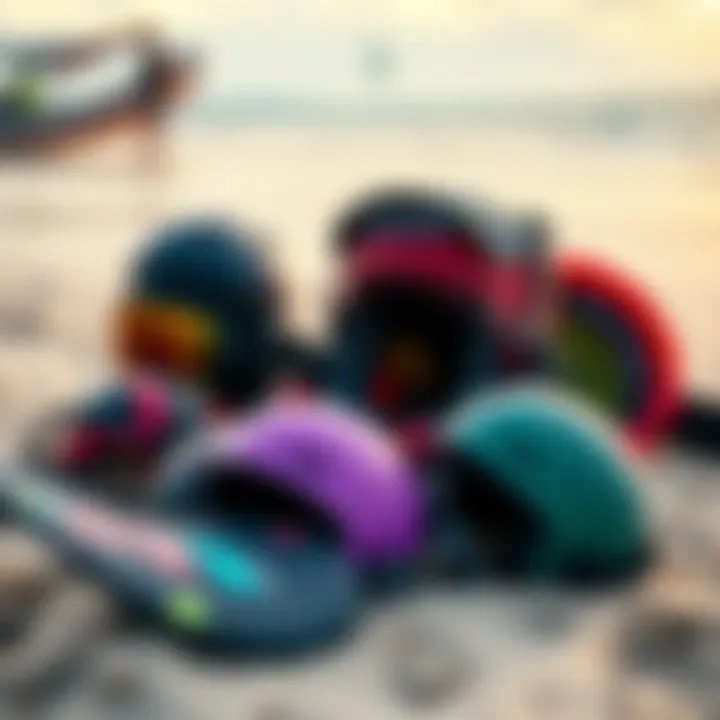
Harness types, such as seat and waist harnesses, serve to distribute pull forces across your body while kiteboarding. A key characteristic of harness types is the fit; they should be comfortable while providing support. Many kiteboarders prefer waist harnesses for their freedom of movement, particularly in freestyle.
The unique feature of a good harness is its capacity to keep you secure without restricting your movements. However, an ill-fitting harness can lead to discomfort and distraction, which is the last thing anyone needs out on the waves.
Impact Vests
Impact vests are often overlooked but serve a critical function in protecting riders from potential falls. A key characteristic of impact vests is their ability to cushion the body upon landing. Riders in Michigan, especially those braving the choppy waters, find these vests essential.
Their unique feature of buoyancy not only assists in keeping you afloat but also adds a layer of protection during those inevitable tumbles. Still, they may limit some range of motion, so it’s essential to find a balance between comfort and safety.
Helmets
Helmets are vital gear that shouldn’t be ignored. A key characteristic of helmets is their ability to protect your head during falls and collisions. In states like Michigan with unpredictable weather, a helmet provides critical protection against unexpected gusts or falling kites.
The unique feature of modern helmets is the incorporation of light materials that don’t compromise comfort or adjustability. As with other gear, a properly fitted helmet is vital, as a loose helmet can be just as hazardous as not wearing one at all.
To sum up, ensuring that you have the right gear is essential not only for optimal performance but also for your safety while kiteboarding in Michigan. Getting it right makes all the difference as you navigate the thrilling waters.
Techniques and Skills Development
The adventure of kiteboarding is full of thrilling experiences and challenges, but it all begins with mastering the foundational techniques and skills necessary for successful riding. This section delves into the various methods employed when learning to kiteboard, emphasizing that becoming proficient in kiteboarding is not only about having the right gear—though that is important—but also about honing techniques that can turn a novice into a skilled rider.
Focusing on both basic and advanced techniques helps unlock the full potential of kiteboarding, allowing riders to take advantage of optimal weather conditions and creatively engage with the water and wind. The skills developed through the practices included here will not only enhance personal enjoyment but significantly contribute to safety in various kiteboarding scenarios.
Basic Kiteboarding Techniques
Launch and Land Techniques
Launching and landing is at the very heart of kiteboarding. Mastery of these techniques ensures that a rider can get on the water without fuss, which is essential for safety and enjoyment. One of the key characteristics of launch and land techniques is precision; getting it right can mean the difference between a successful ride and a potentially hazardous situation.
During launch, a rider must position their kite correctly while paying attention to wind direction. This attention to detail offers the benefit of a smooth ascent into the air, minimizing risks. The unique element here is the coordination between the rider and any assistants who might help with the launch. Without effective communication, unexpected mishaps could occur, leading to injury or damage.
As for landing, it requires extreme focus. The kite must be brought down gently and placed in a safe position—usually on its back or in the power zone to avoid crashing it into other riders or objects. Mastering these landing techniques provides a better overall experience on the water and enhances safety for everyone involved.
Control and Steering
Control and steering are the bread and butter of proficient kiteboarding. These skills impact how a rider maneuvers the kite, which in turn affects speed, direction, and overall stability on the water. Control can be achieved through the right use of the control bar and lines, emphasizing the importance of understanding how to apply pressure and change the kite's angle according to wind conditions.
One key characteristic of control techniques lies in adjusting the kite's position relative to the wind. This principle leads to an enhanced riding experience, allowing for smoother transitions and energy-efficient movements. A well-controlled kite reacts responsively to the rider's commands, providing a significant advantage in various kiteboarding scenarios.
A unique feature of steering is learning to harness wind pressure effectively. This advantage allows riders to perform better while minimizing fatigue. However, steering does require practice and familiarity with different wind conditions, which can serve as drawbacks for some. Over time, building these skills can lead to impressive maneuverability on the water.
Advanced Maneuvers
Jumping Techniques
For many kiteboarders, jumping represents the pinnacle of the sport, showcasing not only skill but also confidence. Jumping techniques involve a combination of precise kite positioning, body movements, and timing. This advanced skill serves to elevate the ride, providing a thrilling experience that many seek to master.
A distinctive characteristic of jumping techniques is the utilization of wind lift. Kiteboarders learn to time their jumps with the kite’s pulling power, which can result in impressive air time. This aspect adds an exhilarating layer to riding that captivates both novices and seasoned riders alike.
Despite the excitement, jumping does carry risks; landings can be tricky, especially in turbulent conditions. Moreover, learning to jump requires practice—it’s not something that can be picked up overnight. Nevertheless, each successful jump builds a rider's confidence and pushes them further into exploration of the sport.
Tricks and Stunts
Just as jumping compels many to kiteboard, tricks and stunts represent an art form within the sport. These maneuvers can turn an average kiteboarder into a spectacle, showcasing creativity and technical skill. Tricks usually involve various combinations of flips, spins, and grabs while airborne, requiring a unique blend of timing, control, and body awareness.
The beauty of tricks lies in their diversity; riders can adapt them based on their own style and level of skill. As a result, learning tricks serves not just as a way to impress peers but also contributes immensely to personal growth within the sport. Engaging in this aspect cultivates a sense of community as tricks often become a means of unofficial competitions among friends.
However, challenges exist. As with jumping, tricks require commitment to learn and perfect. The appeal of nailing an impressive stunt can often tempt riders to push their limits too quickly, risking injury. Thus, practicing in safe environments and gradually building on skills becomes paramount to maintain both thrill and safety.
"Learning kiteboarding techniques involves patience and perseverance, but the rewards are worth the effort involved in mastering the sport."
Safety Practices for Kiteboarders
Kiteboarding, while exhilarating, possesses inherent risks that can't be ignored. Safety practices are pivotal for all levels of riders—beginners and veterans alike. Prioritizing safety is not only about ensuring your well-being but also about contributing positively to the kiteboarding culture in Michigan. Michiganders enjoy vast waters and strong winds, which can lead to unpredictable conditions. Therefore, understanding and implementing safety measures can dramatically reduce accidents and enhance everyone's experience on the water.
Understanding Risks
Identifying Hazards
Before even launching your kite, it is crucial to be aware of potential hazards. Identifying risks involves observing your environment, such as identifying shallow waters, strong currents, or other kiteboarders nearby. Recognizing these hazards can make all the difference on a windy day at Lake Michigan.
A significant characteristic of identifying hazards is the emphasis on situational awareness. It's about keeping your eyes peeled and using common sense. For example, if you notice dark clouds rolling in or sudden shifts in wind direction, it might be time to pack it up.
The advantage of cultivating this awareness is multi-faceted. You not only ensure your safety but also contribute to the overall atmosphere on the water by preventing accidents. The downside? It requires you to be mentally engaged and alert, which can be tiring.
"Stay sharp. The water can change from peaceful to perilous in a heartbeat."
Creating a Safety Plan
A safety plan acts like a roadmap for your kiteboarding sessions. It’s not just a checklist; it’s your lifeline. This plan should include everything from designating a safe area for launching to establishing a communication protocol with others on the water.
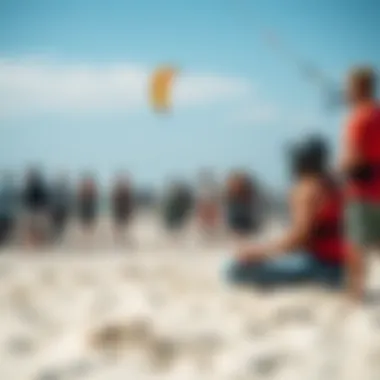
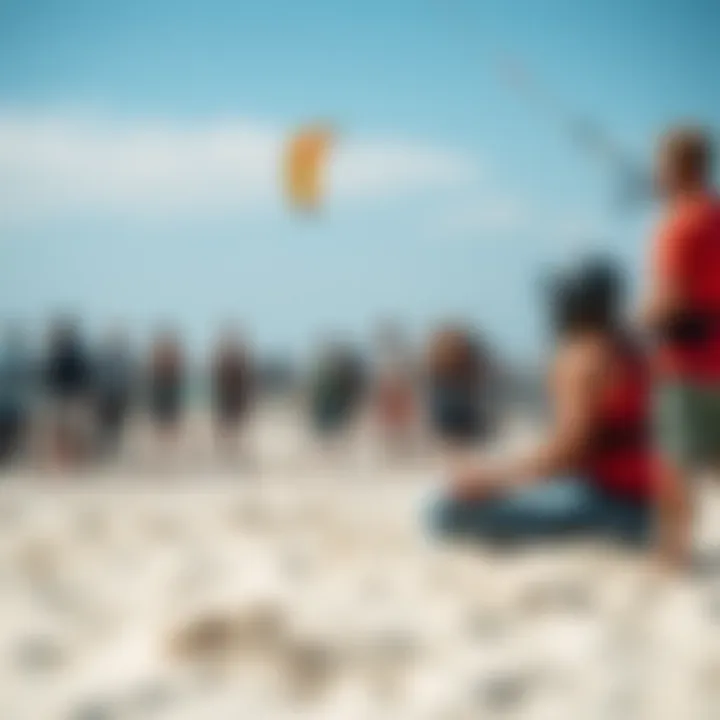
The key characteristic here is preparation. By planning ahead, you're setting up a framework that allows you to respond effectively in emergencies. For instance, if a sudden gust throws you off balance, knowing how to approach a safe landing can save you significant trouble.
The unique feature of a well-thought-out safety plan is that it accounts for various scenarios—from minor mishaps to full blown emergencies. Its advantages are clear: having a plan instills confidence in both seasoned riders and new enthusiasts. The downside could be the complexity of planning, which might deter some. However, taking time for this groundwork is often well worth the effort.
Emergency Procedures
When the unexpected happens, having emergency procedures at hand can mean the difference between a fortunate escape and a tragic accident. Knowing what to do in a moment of panic can save lives and injuries can often be avoided.
Self-Rescue Techniques
Self-rescue techniques are designed to help kiteboarders regain control in chaotic situations. Whether it’s a tangled line or a sudden wind shift, knowing how to self-rescue transforms a potentially dangerous event into a manageable one.
The main characteristic of self-rescue techniques is that they empower the kiteboarder. For example, if the kite crashes into the water, knowing how to detach from the lines and return safely to the shore is crucial. The beauty of self-rescue lies in its simplicity; learning these techniques does not require extensive training but rather some practice and common sense.
The advantages include fostering independence and building your skill set, but the challenges are there, too. Beginners might find these techniques overwhelming, especially in high-stress situations. Thus, practicing in controlled environments is essential for improvement.
Calling for Help
Sometimes, despite your best efforts, situations can spiral out of control. Calling for help is an essential lifeline. It might not sound adventurous, but knowing whom to call and how to communicate the urgency can be vital.
The key characteristic of calling for help is effective communication. Whether it’s a friend onshore or local authorities, being clear about your location and condition is critical. Practicing this communication can have a significant impact, especially when time is of the essence.
In this case, the unique feature is the reliance on external support; having a network of fellow kiteboarders can enhance safety. These connections create a robust community where everyone looks out for one another. The downside? Depending on others might not always yield timely help, particularly in remote areas.
The Kiteboarding Community in Michigan
The kiteboarding community in Michigan serves as the backbone of the sport, uniting enthusiasts of all levels and creating a shared space for knowledge, experience, and camaraderie. Through clubs, organizations, local events, and informal gatherings, kiteboarders find opportunities not just to ride the waves but also to forge lasting connections with others who share their passion. This community plays a vital role in elevating kiteboarding from merely a thrill-seeking pastime to a rich cultural experience.
The importance of such a community cannot be overstated; it provides resources for beginners, opportunities for skill enhancement, and a platform to promote safety and awareness among kiteboarders. The support and encouragement from like-minded individuals can make a significant difference, especially for novices who might feel overwhelmed by the sport's learning curve.
Clubs and Organizations
Various clubs and organizations have sprouted across Michigan, focusing specifically on kiteboarding. These groups often organize group rides, share tips, offer lessons, and sometimes even push for legislation that helps protect kiteboarding-friendly spaces. Being part of such an organization allows members to tap into a wealth of knowledge and experience.
For instance, the Michigan Kiteboarding Association (MKA) is a notable entity that works hard to bring riders together. Members often benefit from discount deals on gear and equipment through partnerships with local vendors. Moreover, these organizations are pivotal in nurturing a sense of belonging within the kiteboarding community.
Events and Competitions
Events and competitions serve as significant milestones in the kiteboarding calendar, bringing excitement and engaging local practitioners in friendly rivalry.
Annual Tournaments
One of the standout features of the kiteboarding scene in Michigan is the annual tournaments. These events draw in not just local participants but also professional kiteboarders from other regions, enhancing competition. Tournaments often tackle the winter chill, taking place during summer when the winds are favorable. This not only heightens the experience of competitors but also attracts audiences who appreciate the extreme skills displayed in maneuvers and tricks.
More than just competitions, these tournaments establish a sense of community. Local businesses often support them, and they can lead to sponsorships, boosting the local economy. However, it’s worth noting that participating in these events usually requires a solid understanding of safety measures and competition rules.
Local Gatherings
In addition to formal tournaments, various local gatherings play an equally crucial role in fostering the kiteboarding community. These informal meetups allow riders to connect, share experience, and learn from each other in a relaxed setting. It could be as simple as a weekend gathering at a favorite kite beach spot, or a planned event to test the latest kite gear.
Notably, these gatherings are beneficial as they often spur informal mentorships, enabling newcomers to gain insights that can't always be taught in formal settings. It also allows experienced riders to share tips on technology and technique, creating a rich environment for learning. However, since these events are less structured, they can sometimes lead to safety issues if participants don't follow best practices.
In essence, whether through formal tournaments or local gatherings, the kiteboarding community in Michigan thrives on collaboration, fostering a deep sense of belonging and an exchange of knowledge that benefits everyone.
Engaging with the kiteboarding community in Michigan not only improves your skills but enriches your experience on the water.
For more information about kiteboarding in Michigan, visit The Michigan Kiteboarding Association and check community discussions on platforms like Reddit for tips and networking.
Exploring The Cultural Aspect of Kiteboarding
The intersection of kiteboarding and culture in Michigan opens a fascinating vista that extends beyond the mere thrill of riding the waves or catching air. It's about community spirit and artistic expression, representing both a lifestyle and an adventure. This section sheds light on the cultural tapestry surrounding kiteboarding in Michigan, showcasing how art and ecological responsibility blend harmoniously with the sport and offering enthusiasts a richer experience.
Art and Photography
Kiteboarding Photography
Kiteboarding photography captures the essence of the sport in its most vibrant form. It's not just about snapping pictures; it’s about freezing moments of triumph over nature. The stunning visuals can convey the raw excitement and the serene beauty of the Great Lakes, which serve as a breathtaking backdrop for kiteboarders of all skill levels. Many passionate photographers venture out to the shores, armed with their cameras, attempting to encapsulate the dynamic movements of the sport against a canvas of colorful kites and splashing waves.
Key characteristics of kiteboarding photography include high-speed shots that illustrate the grace and power of the riders, often requiring skill in timing and positioning. This art form holds significant appeal for those in the kiteboarding community, creating an opportunity to share their experiences and inspire others. The unique feature of kiteboarding photography is its ability to convey emotion through images – a successful jump or a graceful glide can evoke the feeling of freedom or the thrill of adventure. However, it’s not without its challenges, including the technical difficulty of capturing fast-moving subjects under varying light conditions.
Art Inspired by Kiteboarding
Art inspired by kiteboarding pushes the boundaries of creativity. Artists draw from the fluid motions and vibrant energy of the sport to create pieces that resonate deeply with both participants and admirers. This form of artistic expression helps to communicate the joy and rush kiteboarders experience, often translating into paintings, sculptures, and digital art that celebrates the culture.
The essence of such art lies in its reflection of movement and flow, incorporating elements that mirror the unpredictable nature of wind and water. This artistic venture is beneficial as it cultivates a deep appreciation for the sport, highlighting its significance both as an activity and a lifestyle. One of the unique features here is the community aspect; artists and kiteboarders often collaborate, leading to events like local exhibitions or competitions that further showcase this relationship. Yet, creating art inspired by kiteboarding can be subjective, and not every piece resonates with every viewer, which can be a point of contention among enthusiasts.
Sustainability and Environmental Impact
Eco-Friendly Practices
As kiteboarding grows in popularity, so too does the responsibility that comes with enjoying Michigan's natural landscapes. Embracing eco-friendly practices is vital to ensure that the beautiful sites cherished by kiteboarders remain pristine for future generations. This aspect emphasizes sustainability, encouraging participants to adopt practices like cleaning up after outings, minimizing their footprint on delicate ecosystems, and using biodegradable materials when possible.
By fostering an ethos of care and responsibility, the kiteboarding community can contribute positively, raising awareness about environmental issues while participating in their favorite sport. The unique feature of these practices is a dual focus on fun and respect for nature, creating a community that enjoys kiteboarding while also safeguarding the environment. However, this commitment requires continuous education and effort; without it, the very beauty that draws people to kiteboarding can be endangered.
Community Clean-Up Initiatives
The kiteboarding community in Michigan often rallies together for clean-up initiatives, further solidifying the bond among its members while demonstrating a shared commitment to environmental stewardship. These events provide a great opportunity for locals and visitors alike to improve the beaches and water areas that they love to kiteboard on. Participants engage in activities that not only benefit the environment but also strengthen community ties.
Highlighting the importance of collective action, these initiatives promote group participation and foster camaraderie. This aspect is beneficial as it attracts attention to the responsibilities that come with enjoying natural spaces and engages people in a conversation about sustainable practices. One unique feature of these clean-up events is the fun and rewarding atmosphere they create, making community service enjoyable rather than a chore. However, ensuring consistent participation can sometimes be challenging, and maintaining momentum requires ongoing enthusiasm and effort from within the community.















